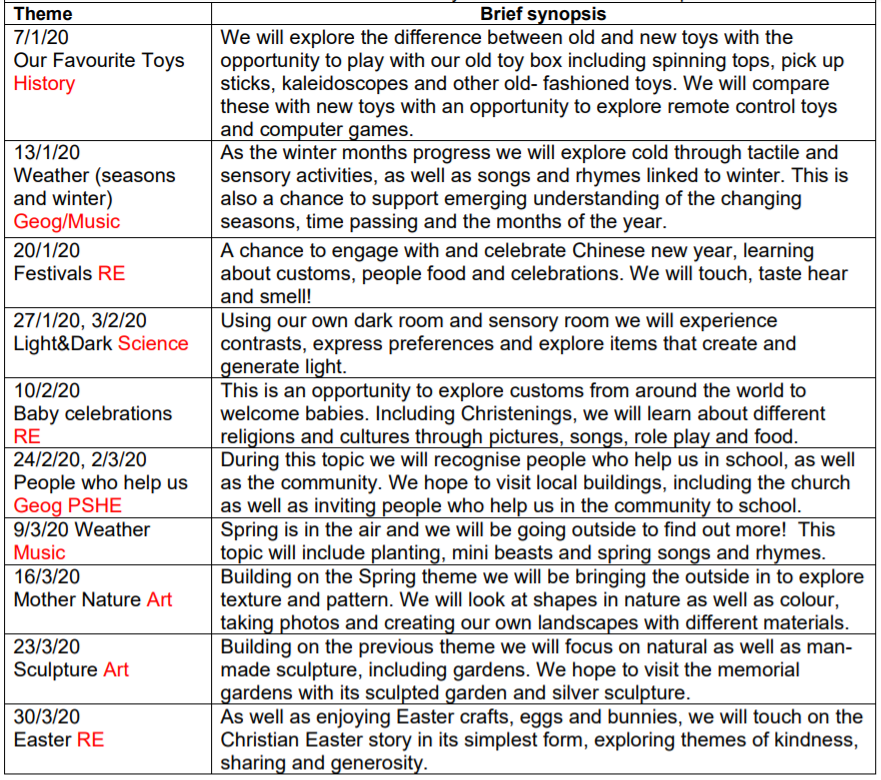Dear Parents and Carers,
We want to share with you the topics and units of work being covered by Class this term, so that you can
talk to your children about their lessons and support them with activities. We are looking forward to an
exciting and busy half term and we hope that the children will enjoy it.
My Communication
Communication is taught throughout the week, both informally and through taught sessions. We
encourage children to communicate through their preferred means which could include pictures,
communication devices, spoken sounds and words and Makaton. Children are given opportunities to
make choices and express preferences frequently. All children will take part in small group or individual
communication sessions as indicated in their health care plans.
Early Reading and Phonics
On Mondays we’ll be exploring Stories and narrative. Children will develop their reading skills, from
recognising pictures and familiar items or phrases, to sequencing parts of stories, identifying what comes
next, and constructing their own narratives in pictures or words. Some pupils will use this time to engage
with Social Stories related to their personal plans.
Alongside this, we will providing a wide range of activities related the phases in phonics. Some of our
learners are becoming aware of the sounds around them, as well as being able to identify and
differentiate between them. They will learn to attend to different sounds and children will be encouraged
to imitate and create sounds through play and music.
Some children will be learning phase 1 sounds set 1 and 2 (s,a,t,p,l,m,n,d). They will be encouraged to
recognise graphemes (sound pictures) and phonemes (sounds attached them).
A few learners will be practicing how to recognise the first sound in words and will be supported to blend
phase one sounds, in line with the Read Write Inc. guidance. These skills are consolidated throughout
the week.
This term the focus stories and texts linked to afternoon themes will be; Where’s My Teddy, Chinese
New Year Stories, Can’t You Sleep Little Bear, Something Special, Topsy and Tim Series,
Whatever The Weather and the Easter Story. These stories link with our afternoon themes wherever
possible.
Mark Making and Writing
On Thursday we’ll be exploring mark making and early writing in response to pictures, songs and stories.
This includes physical development opportunities for children to develop the motor skills needed to make
marks and to write. At least once a term we will do Write Dance which includes large gross motor
movements to music.
My Thinking
The EYFS/KS1 environment provides opportunities for children to problem solve, compare, sort and
explore mathematical skills such as number, shape, space and measure. This is facilitated throughout
the week through a combination of pupil led play, small groups and 1:1 sessions led by an adult.
On Wednesdays the focus is on number, including early calculations for some pupils. We will work on
consolidating recognition of numbers up to 3, 5 or 10, as well as experiencing quantity and the concepts
of more and less in a tactile way. Some pupils will be learning to count objects to match numbers. A few
pupils will be becoming familiar with add and take away through games and more formal paired work.
Where possible maths reflects the theme for the week, e.g. buying three toys at the toy shop.
My Thinking on Fridays will include everyday skills such as sequencing events through pictures, following
a visual sequence of activities and identifying what comes next.
Themes – Areas Of Learning
Themes are set up to reflect areas of learning including Expressive Arts, Understanding Of The World
(Including technology, humanities and scientific enquiry), Personal Social and Emotional Development,
Physical Development as well as Communication and Thinking skills. Each learning station focusses on
a different skill within those areas and includes sensory and tactile resources to explore.

Things that you could do at home:
Sing familiar rhymes and encourage engagement with sounds.
Join in with play and interaction wherever possible. Mirror children’s play to make connections at their own
level. Share stories together, take opportunities to count aloud and recognise shapes in the environment
Explore the outdoors in all weathers where possible and encourage curiosity
Here are a few websites that may help to support your child’s learning:

